Mark Sisson's Blog, page 281
November 11, 2014
Expert Certification Adds Accreditation and Advisory Board
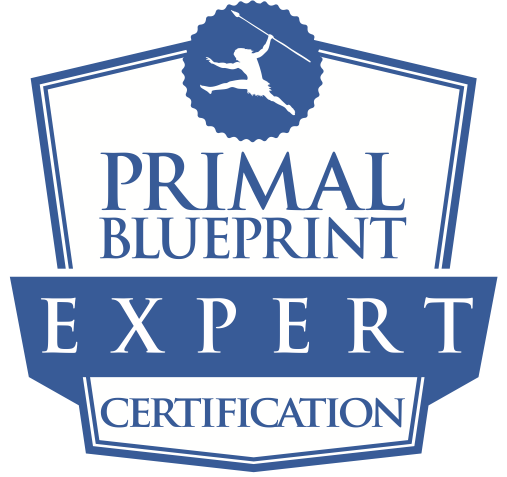 As you probably know, the Primal Blueprint Expert Certification that launched in late August has been extremely well received, and hundreds of students are currently studying to become Primal Blueprint Certified Experts. In fact, we have 74 graduates already, spanning 24 states and 7 countries, and you can read all about them at the Certified Expert Online Directory. While we are pleased to deliver a successful product to an eager audience, I’m also enthusiastic about the bigger picture of having the primal/paleo/ancestral health movement represented in a general sense when it comes to advanced professional education in the areas of diet, exercise, and health science.
As you probably know, the Primal Blueprint Expert Certification that launched in late August has been extremely well received, and hundreds of students are currently studying to become Primal Blueprint Certified Experts. In fact, we have 74 graduates already, spanning 24 states and 7 countries, and you can read all about them at the Certified Expert Online Directory. While we are pleased to deliver a successful product to an eager audience, I’m also enthusiastic about the bigger picture of having the primal/paleo/ancestral health movement represented in a general sense when it comes to advanced professional education in the areas of diet, exercise, and health science.
It’s a sure bet that progress in mainstream health, fitness, and medical education will happen at a slow pace. As my friend Dr. Doug McGuff says, “Science and mainstream medicine will come around, but it will take 20 years. I’d rather live on the forefront of health progress than wait.” Don’t hold your breath for our hallowed medical schools to start drilling the docs of tomorrow on the pro-inflammatory effects of gluten ingestion, or why the trigs-to-HDL ratio blood values trump total LDL values when trying to assess heart disease risk factors. Registered Dietitians will likely be still studying off the US Government’s beloved ChooseMyPlate for a while longer before they throw the Primal Blueprint Food Pyramid into their course syllabi.
Even the educational tracks of personal training, exercise physiology, chiropractic, and functional medicine can benefit from exposure to the science and practical techniques favored by our (relatively) small and progressive healthy living movement. The cert is turning out to be a wonderful way to make inroads against conventional wisdom, for every hands-on professional that completes the certification program and starts to spread the word to clients and professional peers is changing the world, one small step at a time.
Along those lines, I’m pleased to announce two recent efforts to add legitimacy and credibility to the certification program, through the formation of the Primal Blueprint Expert Certification Advisory Board, and by becoming an accredited continuing education provider with the National Academy of Sports Medicine (NASM)–an organization considered by many in the fitness game to be the gold standard for personal trainer certification.
Introducing the Cert Advisory Board
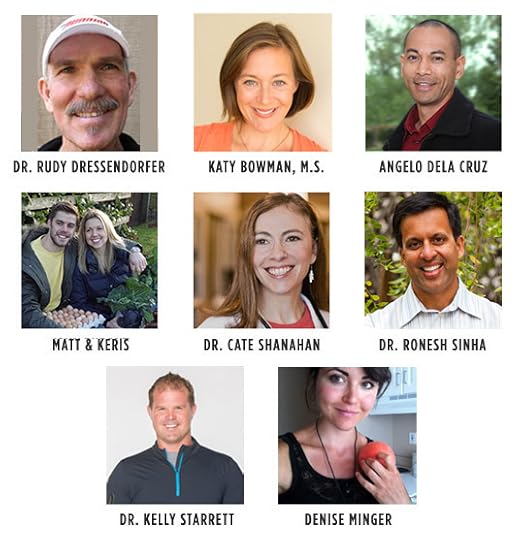
Our Advisory Board was created to reflect the support and inspiration offered by an elite group of professionals in the fields of health, wellness, medicine and fitness to the development and ongoing refinement of the program. While you’ll find the work of these folks often referenced in the course material, including direct quotes, I must be clear that they are independent from our company, have no official accountability or byline credit for the course programming, and are not compensated for their service on the Advisory Board. We simply love these folks dearly, greatly respect their work, and have and will continue to follow their efforts closely as thought leaders in the evolutionary health movement. As we expand our continuing education offerings in the future, we anticipate engaging in joint ventures with thought leaders that align with Primal Blueprint principles.
Visit this link to learn more about each member of the Advisory Board. Briefly, here is quick overview of our original members:
Katy Bowman, MS is the red-hot author of Move Your DNA. You’ll get to know Katy in great detail as the launch of Don’t Just Sit There is imminent. This is our joint effort to present a comprehensive multimedia online course to solve the excessive sitting issue in the modern workplace.
Angelo dela Cruz is our PrimalCon superstar (he’s presented at all 9 of them!), a phenomenally talented ninja warrior athlete, respected personal trainer in the San Francisco Bay Area, and wonderous 1:1 healer. The creator of the fantastic Daily VitaMoves website—check it out!
Dr. Rudy Dressendorfer is a longtime professor of exercise physiology now based in Northern California where he terrorizes the 60+ age group crowd in multisport endurance events. He is doing some groundbreaking work to help combat the alarming incidence of swim deaths in triathlon events in recent years. Rudy is the one who proclaimed the course on a par with one of his upper division university courses in the health sciences.
Keris Marsden and Matt Whitmore: The UK’s fittest, most knowledgeable and most engaging couple. Authors of the runaway hit The Paleo Primer (called Fitter Food back in the UK, where it was also a bestseller) and super-energetic PrimalCon presenters.
Denise Minger: Denise’s Death by Food Pyramid is the go-to resource for understanding how we got ourselves into the incredible mess that is the Standard American Diet and flawed conventional wisdom about what is healthy eating. She is an impeccable researcher and prolific writer (check out RawFoodSOS.com), who recently officially joined the Primal Blueprint team as a writer/editor/researcher.
Dr. Cate Shanahan: Y’all know her by now from her regular Primal Blueprint Podcast appearances and also through her unique Primal Advantage 1:1 metabolic consulting program. The pre-eminent MD in the primal/paleo scene, and the personal consultant to the LA Lakers and NBA superstar Kobe Bryant.
Dr. Ronesh Sinha: Author of the South Asian Health Solution, Ron is fighting the battle on the front lines, working with leading San Francisco Bay Area companies and getting people out of high risk heart disease categories with primal aligned diet modification. He is turning lots of heads in the medical community with phenomenal blood reports from patients going about it with diet modification instead of drugs.
Dr. Kelly Starrett: An incredibly dynamic presenter who created the highly acclaimed MobilityWOD website and co-wrote the bestselling book, Becoming a Supple Leopard. Five minutes with this guy will rock your world. Check out one of his viral Voodoo floss videos on YouTube if you have a nagging joint issue.
PB Certification Accreditation with NASM
 We are pleased to inform you that the Primal Blueprint Expert Certification program is now an approved provider of continuing education units for the National Academy of Sports Medicine (NASM). For over 20 years, NASM has provided scientifically validated knowledge in its personal trainer certification programs. Composed of scientists, coaches, researchers, and athletes, NASM as an organization continues to incorporate only the best and most current fitness information and continuing education courses into its personal trainer certification programs. As such, NASM as an organization is considered by most industry professionals as the gold standard for certification in fitness.
We are pleased to inform you that the Primal Blueprint Expert Certification program is now an approved provider of continuing education units for the National Academy of Sports Medicine (NASM). For over 20 years, NASM has provided scientifically validated knowledge in its personal trainer certification programs. Composed of scientists, coaches, researchers, and athletes, NASM as an organization continues to incorporate only the best and most current fitness information and continuing education courses into its personal trainer certification programs. As such, NASM as an organization is considered by most industry professionals as the gold standard for certification in fitness.
After a rigorous review process by NASMs expert panel, the Primal Blueprint Expert Certification program has been approved for 1.9 continuing education units (CEUs) for certified personal trainers achieving licensing through NASM. This is big, considering that NASM certified trainers only need 2.0 units every two years to stay certified. So, if you’re a NASM trainer, upon completion of our course, you’ll have nearly met your entire CEU requirement for two whole years! And even if you’re not a NASM trainer, you’ll have the distinction of achieving a level of knowledge validated by one of the world’s leading organizations for fitness professionals.
Shout Out to the Students!
I must give another plug here for the incredible contribution that our beta-testers and early students have made to the program. We have received a ton of feedback from students, both from formal surveys and informal email communications. This feedback has often come in the form of suggestions to clarify confusing material in the course text, or challenges to examination questions that seem unclear and potentially unfair. We carefully evaluate every morsel of feedback we receive about the course, and absolutely love the ability to make improvements to the course in real time. Believe me, it’s a lot more satisfying than fielding those emails like, “Hey, there’s a typo on page 321 of The Primal Blueprint.” Oops, okay we’ll file that away for our next print run…Anyway, several folks deserve special recognition for the super-enthusiastic and insightful contributions to the coursework editing. First, our beta-testing group (and earliest Certified Experts), who helped get the Cert ready for prime time! They are, in graduation order: Michael Dilandro, Chris Adams, Tina Leaman, Elle Russ, Leslie Klenke, Amy Lucas, and Daniel Rinck.
Students who took the time and energy away from their personal studies to contribute to the greater good of the course (by finding typos here and there, or reminding us when we were US-centric in the commentary, pointing out potential improvements of confusing passages, finding some typos here and there, and by royally busting our chops when they missed questions that seemed unfair and had a legitimate gripe!) include Aldvin Danenberh, DDS, Colleen Conners-Pace, Brian Lamoureux, and Irma Jager.. We also greatly appreciate the interest in the Expert Certification from the folks at Paleo Magazine. Their very own Ashleigh Van Houten took the entire course and graduated as a function of her doing a story on the Cert course. How’s that for participatory journalism! (If you haven’t seen this mag check it out, I’m gonna start doing a regular column in 2015.)
Furthermore, as I indulge my passion for research, communicating with thought leaders in the movement about emerging topics, or evaluating healthy differences of opinion from respected experts, I can revise or update course material accordingly. Our commitment is to have this digital educational experience be easy to understand and progress through, be comprehensive in scope, and always up to date. It’s great fun on our side to present such a dynamic program, and I know the students and graduates would agree that they are having fun investing in themselves and gaining knowledge, clarity and empowerment. If you’ve been thinking about taking things to the next level, with your personal goals and knowledge or with your clients if you are provider, I hope you can join the party here soon! And don’t forget: The introductory price of $795 ends on December 15, so you still have plenty of time to lock in the early bird pricing. But don’t wait too long, the introductory offer will be over before you know it!
You CAN Lose Weight and Get Healthy. Find Out How>>



November 10, 2014
Dear Mark: Kerrygold and GMOs, Primal Jainism, and Saffron as a Supplement
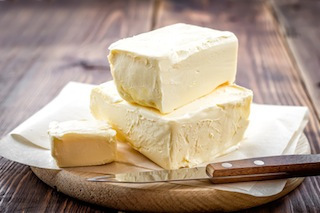 For today’s edition of Dear Mark, I’m answering three questions. First, the matter of Kerrygold butter. It’s the go-to option for Primal butter eaters, but it’s also neither organic nor GMO feed-free. Is this a problem and should I withdraw my recommendation? Next, can a person who eats no meat, no eggs, no seafood, no tubers, and a limited selection of fruits and vegetables go Primal? Probably not, but that’s not the end of the world. And finally, what’s the deal with using saffron as a supplement? It appears to be effective at reducing appetite, but what else does it do?
For today’s edition of Dear Mark, I’m answering three questions. First, the matter of Kerrygold butter. It’s the go-to option for Primal butter eaters, but it’s also neither organic nor GMO feed-free. Is this a problem and should I withdraw my recommendation? Next, can a person who eats no meat, no eggs, no seafood, no tubers, and a limited selection of fruits and vegetables go Primal? Probably not, but that’s not the end of the world. And finally, what’s the deal with using saffron as a supplement? It appears to be effective at reducing appetite, but what else does it do?
Let’s go:
I saw Kerrygold as one of your recommended butters. It is not organic & it’s made from cows that do receive some GMO grain.
Barbara
So what?
People need to stop chasing dietary perfection. So Kerrygold cows may get a maximum of 3% of their food from GM soy and/or corn? Is that really a problem?
90% of their diet comes from Irish grass. Those Irish Spring soap commercials from the 90s with ridiculously green grass? Cows are gorging themselves on that stuff. For 312 days out of the year, they’re eating wild cow salad and living the dream. And when they’re not, when fresh grass isn’t available, they’re still getting the vast majority of their calories from dried and fermented grass harvested the previous season.
Obviously, the tiny amount of grain in their feed worries you. We talk a lot about grass-fed. Studies on pastured (not 100% grass-fed and finished) dairy products confirm that “merely” pastured is plenty good enough. Just recently, a study placed rodents on one of two diets: a diet high in pastured cream or a diet high in conventional cream. Animals on the high-pastured cream diet had lower body fat, better blood lipids, lower inflammation in body fat tissue, and less liver fat despite eating more calories overall. Furthermore, the pastured cream reduced intestinal permeability.
How about the GMO grain in the cow diet? I view GMO foods with caution, but not terror. While I’d rather not eat them if I can help it (and simply going Primal eliminates most of them), I’m not worried about eating a food produced by an animal that might have eaten a small portion of GMO soybeans. Again, GMO grains make up 3% of their diet at the most. In the studies by Seralini showing health issues in GMO-fed rodents, those rats were eating 11% of their calories as GMO corn. And the probable cause of the health problems wasn’t the genetic modification, it was the Roundup herbicide GMO corn marinates in. Kerrygold butter doesn’t have Roundup residue. Heck, not even grain-fed butter from the land of GMO corn – the United States – shows evidence of Roundup residue. You’re safe here.
What about the organic issue?
Kerrygold dairies may not be organic in name, but they don’t use pesticides, they rely on natural rain-fed irrigation, and their soil is low in fat-soluble pollutants like dioxins (PDF). And besides, grass-fed trumps organic when it comes to animal foods like butter, or beef, or lamb. If you don’t trust me, see for yourself:
Go to your local grocer that carries Kerrygold. Walk to the dairy section. Wrap your hand around a bar of Kerrygold. Give it a gentle squeeze. See how it gives? See how you leave an indentation? That’s because those cows have been eating so much green grass that their butterfat has been imbued with omega-3 fats and conjugated linoleic acid, which are unsaturated and thus softer at refrigerated temperatures.
Now unwrap it. Yes, right there in the store. You’ll be buying it in a minute anyway. See how yellow it is? That’s beta-carotene from – again – all the green grass those cows are eating.
Now give it a little taste. Get some of that sweet Kerrygold on your tongue. Savor its descent back into cream.
Now do the same for the random organic butter (pictured right). Give it a squeeze. You can’t; it’s rock hard. Give it a look; it’s white with maybe a tinge of pale yellow. Now give it a nibble; it melts into grease, not creamy velvet. When it comes to butter, the organic part doesn’t matter nearly as much as the grass-fed part.
If you can get fully grass-fed and finished organic local raw cultured butter, do it. If you can get it without spending $12 a pound, go for it. But don’t let the perfect become the enemy of the good. And in this case, your idea of perfect isn’t really even perfect.
Sorry If I’m being too blunt, Barbara. I just don’t want you to miss out on a great source of fat and micronutrients, spend more money than you need, and waste time and energy looking for that perfect butter that probably isn’t even out there.
I have a friend and co-worker that wants to try going Primal, but he practices Jainism, which has some strict dietary rules. For example, he can’t eat meat, eggs, or anything that grows underground — essentially lacto-vegetarianism. But, he also thinks he has inflammation issues from dairy. Do you have any suggestions for him on how to possibly go Primal?
Thornton
That’s going to be tough. The dietary restrictions of Jainism are quite strict, revolving around the complete and utter reverence for all life. They make an exception for certain plants, since humans have to eat something and plants are the least “conscious” or aware of being eaten.
Many fruits and vegetables are off limits because the risk of collateral insect death is too great.
Figs are not eaten to avoid killing the fig wasp, an insect that spends its larval stage inside the fig fruit.
Multi-seeded fruits may house worms and so are forbidden.
Tiny flies can get stuck to the nooks and crannies lining the surface of broccoli and cauliflower. Washing usually doesn’t remove them, so to be safe these vegetables are simply avoided.
Dairy is allowed, but with caveats. Calves get first dibs on the milk. Once a cow is milked, taking care to let the calf get the first 1/3 of the milk, it must be boiled three times and consumed within 24 hours. Yogurt is made fresh daily, and never using the previous day’s batch as a starter. Cheese isn’t allowed. All food in general is to made at home.
It’s really a ton of work.
The only way, really, would be with lots of dairy. If cow dairy is inflammatory for your friend, he can try goat dairy. Lots of people seem to fare better with goat milk than cow milk, and several studies support these anecdotes:
Goat milk (and donkey milk, if you can get your hands on it) is both anti-allergenic and anti-inflammatory, regulating the intestinal immune response at the cellular level.
Goat milk (and, again, donkey milk) possesses immunomodulatory effects and even helps the body release nitric oxide, a vasodilator that improves vascular function.
Goat milk glycans (carbohydrates that support the healthy gut bacteria and can help the immune system) are more similar to human milk glycans than cow milk glycans; goat milk also contains novel glycans with further health benefits.
But there’s still the question of obtaining sufficient calories. As you say, eggs, meat, seafood are all off the table. So are root vegetables of all kinds – garlic, onions, potatoes, sweet potatoes. That takes care of most dense calorie sources. If he’s Primal, he’s not supposed to eat grains or legumes, which is where most Jains get the bulk of their calories. I’d make some allowances here. Rice is okay, as I’ve said before. Lentils are among the least problematic legumes and require relatively less prep work (you don’t necessarily have to soak lentils, for example) – and the most nutritious. He can eat dosas, a kind of fermented lentil and rice pancake; the fermentation makes them more nutritious and digestible. Here’s a basic recipe. If he’s not interested in making his own, Indian markets often carry fermented dosa batter in the refrigerator section.
Is he going to be strict Primal and Jain? No. But he can definitely glean a few helpful principles from the Primal way of eating.
Hi Mark,
Long time reader and fan here. I just recently read reviews about a saffron extract product that will help suppress appetite to help you lose weight. Can you comment on this? Is it safe/normal to use as an aid? I’ve struggled with losing weight for awhile and I would love to try this out.
All best,
Alex
Like any spice I’ve ever taken the time to study, saffron has pharmacological effects.
There is one study in overweight, healthy women showing that a saffron extract can normalize appetite and reduce snacking. Women in the saffron extract group also lost more weight. This is the supplement used. Reviews aren’t great, but go for it if you’re still interested.
The biggest effects seem to be on subjects with mild to moderate depression. In these folks, saffron is an effective anti-depressant, even in placebo-controlled trials. Saffron can also ameliorate the SSRI-induced sexual dysfunction in both men (and male rats, at least) and women taking pharmaceuticals for depression.
Saffron may also improve certain biomarkers of metabolic syndrome and eyesight in people with age related macular degeneration.
Saffron is safe, but there are some potential issues to watch out for. High doses can cause nausea, which, I suppose, might in a roundabout way reduce appetite (but not healthily). Bleeding, white blood cell count abnormalities, and low blood pressure are also issues at higher, chronic doses. Keep it short and acute if you try it.
There are even reports of saffron having psychoactive effects, and saffron was an integral ingredient in the old timey opium tincture known as laudanum. That’s whole spice saffron, though, not an extract. If you’ve ever watched the HBO show Deadwood (you should, by the way; great show), some of the characters use laudanum.
That’s it for today, folks. Thanks for reading!
You CAN Lose Weight and Get Healthy. Find Out How>>



November 9, 2014
Weekend Link Love – Edition 321
 I hung out with Joel Zaslofsky on his Smart and Simple Matters podcast the other day. We had a great chat that I think you’ll love to hear, so go listen.
I hung out with Joel Zaslofsky on his Smart and Simple Matters podcast the other day. We had a great chat that I think you’ll love to hear, so go listen.
Steve Marsh is an organic farmer from Australia who lost his organic certification after his fields were contaminated and infiltrated by GMO crops from an adjacent farm. Having lost his case against the neighboring farm, he’s $800k in the hole and needs your help.
Research of the Week
Scientists have found a safer alternative to antibiotics that sidesteps the problem of antibiotic resistance. Hopefully, it works.
Performed with proper technique, the full squat is healthiest for your knees and other joints.
Western Eurasian and East Asian populations diverged at least 36,200 years ago.
“Older adults should make nine interruptions for every hour spent in sedentary behavior.”
Turns out that refined olive oil is a better choice for frying than corn, soybean, and sunflower oils.
Low carb diets are good at preventing patients with impaired glucose tolerance from progressing to diabetes.
New Primal Blueprint Podcasts
Episode 41: Listener Question and Answer with Mark Sisson: I talk alcohol, fatty vs. lean meat, fat-burning, confirmation bias (and how to avoid it), and unhealthy psychological relationships with food.
Each week, select Mark’s Daily Apple blog posts are prepared as Primal Blueprint Podcasts. Need to catch up on reading, but don’t have the time? Prefer to listen to articles while on the go? Check out the new blog post podcasts below, and subscribe to the Primal Blueprint Podcast here so you never miss an episode.
Are You the Working Out Type?
The 10 Rules of Successful Exercise
Why I Don’t Trust the Acceptable Daily Intake Levels for Pesticides
The Definitive Guide to Cholesterol
Are You Sacrificing Your Health?
Interesting Blog Posts
A great piece from Tuit Nutrition about obesity’s relationship to poor health: cause or effect (or both)?
Babies will always be better at squatting than adults.
What happens when you eat dog food for a week?
Media, Schmedia
Dr. Ron Sinha discusses the South Asian health crisis (and what to do about it) in India West, a major Indian newspaper in the US.
Slate wonders how our ancestors could have had better teeth than us.
Do we know enough about the bacteria in our guts to deem a particular gut microbiome “healthy”? Maybe not.
These lucky employees get to work from home whenever they want after 6 PM. Weekends, too.
Everything Else
Fresh fruit is the number one snack in Europe, the Middle East, and Africa. In Asia, it’s chocolate, and Latin America likes yogurt. The number one snack in the United States is, of course, the potato chip.
If you’re going to use electronics after dark, slap on a SleepShield.
Remember rajio taiso? Here are some cleaner, clearer videos of the workouts.
New Yorkers, there’s a bone broth stand opening up tomorrow.
Psilocbyin builds (temporary?) new connections between different areas of the brain.
You guys can spare three minutes a week, can’t you?
More and more people are attaching electrodes to their scalps and sending weak electrical currents to alter the firing of their neurons to reduce depression and improve cognition.
See the inside of the entire human body from top to bottom in this GIF.
Recipe Corner
South by southwest chicken soup is the kind of dish you can taste just by reading the ingredients.
Wrap or no wrap, this paleo mu shu chicken is worth making.
Time Capsule
One year ago (Nov 9 – Nov 15)
Cold Turkey vs. Baby Steps: Which Is the Better Approach? – Go all in or test the water – the case for both approaches.
How to Engineer a Successful Day of Sunbathing – If you plan on exposing yourself to unfiltered sunlight, you’d better do it right.
Comment of the Week
Couldn’t you just say: “I don’t trust the acceptable daily intake levels for pesticides because the information is coming from the Federal government”? That does it for me.
– Touché.




November 8, 2014
Crispy Skin Salmon with Nori Vinaigrette
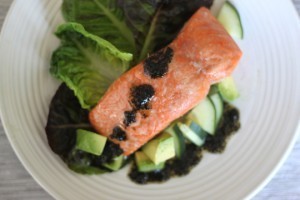 Nori is known and loved as a wrap for sushi, but you don’t need a gob of rice to enjoy the mild-flavored, toasted sheets of seaweed. Toasted nori sheets can be ground into powder (a coffee grinder works well for this) and the powder can sprinkled liberally as a seasoning for meat, seafood, vegetables, sauces and dressings. In other words, if you like the flavor of seaweed you can add nori powder to just about anything.
Nori is known and loved as a wrap for sushi, but you don’t need a gob of rice to enjoy the mild-flavored, toasted sheets of seaweed. Toasted nori sheets can be ground into powder (a coffee grinder works well for this) and the powder can sprinkled liberally as a seasoning for meat, seafood, vegetables, sauces and dressings. In other words, if you like the flavor of seaweed you can add nori powder to just about anything.
Like other types of sea vegetables, nori is a good source of healthy minerals, so the more ways you have to add it to your diet, the better. Mash nori powder up with butter (and melt it over meat and roasted veggies), blend it with sea salt, or, follow this recipe and whisk nori into a vinaigrette.
Here, this inky black dressing adds intriguing flavor to a simple salmon and avocado salad. It would also be delicious over steak and greens or as a dressing for Asian flavored coleslaw.
Servings: 2
Time in the Kitchen: 25 minutes
Ingredients:
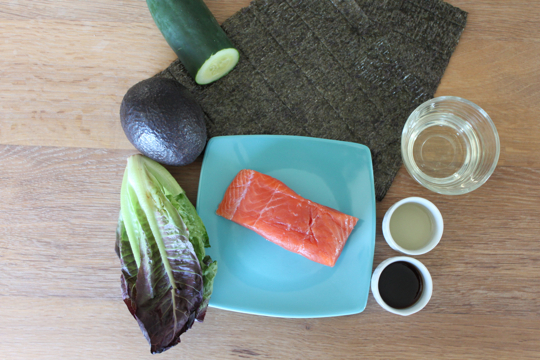
1 to 2 toasted nori sheets (“yaki nori”)
2 tablespoons unseasoned rice vinegar (30 ml)
2 tablespoons coconut aminos (30 ml)
1/4 teaspoon kosher salt (1.2 ml)
1/4 cup cold pressed high-oleic/high-stearic sunflower oil (60 ml)
2, 4 to 6 ounce salmon fillets, skin on (113 g to 170 g)
1 or 2 avocados, cut into chunks
1 cucumber, cut in half moons
Salad greens
Instructions:
Preheat oven to 350 ºF/177 ºC.
Rip nori sheets into pieces. Blend the nori in a coffee grinder (or blender) into a fine powder.

In a medium bowl, whisk the rice vinegar, coconut aminos, salt and sunflower oil into a dressing. Whisk in a little bit of the nori powder at a time, until the flavor is to your liking. Set aside.
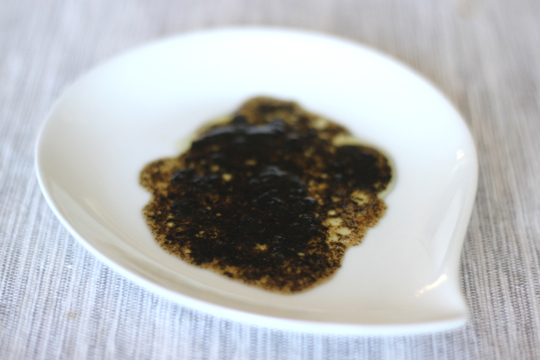
Season salmon with salt and pepper. Heat a drizzle of oil in a large ovenproof skillet over medium-high heat. Place salmon in the skillet skin side down and cook until the skin is crispy, about 5 minutes. Don’t move the fish as it cooks, but do press down gently a few times on the fillets with a spatula so the skin is in full contact with the pan, helping it get crispy.
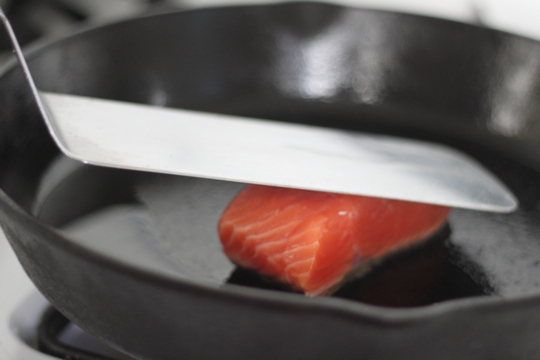
Once the skin is crispy, put the skillet in the oven (don’t flip or touch the fillets, just leave them alone) and roast until the salmon is just cooked through the middle. Cooking time will vary depending on the thickness of the fillets, but is likely to be between 4 and 7 minutes.
In large bowl, toss together the salad greens, avocado, cucumber and nori vinaigrette. Place the salad greens on individual plates and top with salmon.
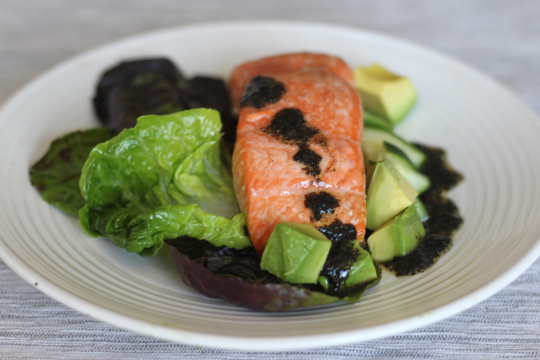
Not Sure What to Eat? Get the Primal Blueprint Meal Plan for Shopping Lists and Recipes Delivered Directly to Your Inbox Each Week



November 7, 2014
A Decade Long Journey: How Primal Living Healed My Crohn’s Disease
It’s Friday, everyone! And that means another Primal Blueprint Real Life Story from a Mark’s Daily Apple reader. If you have your own success story and would like to share it with me and the Mark’s Daily Apple community please contact me here. I’ll continue to publish these each Friday as long as they keep coming in. Thank you for reading!
 Thank you so much for being a leader to a better way of life, an example to people like myself, and a genuine life changer. To understand where my gratitude comes from, I have to tell you my story, which began over 10 years ago.
Thank you so much for being a leader to a better way of life, an example to people like myself, and a genuine life changer. To understand where my gratitude comes from, I have to tell you my story, which began over 10 years ago.
I have Crohn’s Disease, but for the first fifteen years of my life, I had no idea I had it. What I did have was an aching feeling that there was a reason why I had brutal stomachaches nearly every day, why I could eat tons of junk food but never put on weight, and why everything became so much worse when I was stressed. I lived for years without answers, but at fifteen I was finally diagnosed and began a life dependent on medication. My treatment gave me slight relief for a the rest of high school, but every time I experienced stress, my symptoms would rear back up, causing me to leave class and miss important experiences.
The first time Crohn’s sent me to the ER, I was a freshman in college. In rehearsals for my first college play, I began to feel a pain in my abdomen that wouldn’t go away, unlike the cramping that I was used to. After three days in the hospital and receiving heavy doses of antibiotics and steroids, the episode resolved itself. And although I was incredibly weakened by three days of a liquid-only diet, I was still able to perform and return to school, much to my relief.
Little did I know, this episode was only the beginning of my struggle with my health—a struggle that would affect everything in my life. Sure, I had trouble putting on weight and I had the usual array of Crohn’s symptoms, but the real fight was between my disease and my dreams. I constantly wondered, “How am I going to pursue what I’m passionate about? Is Crohn’s really going to dictate how I live and what I can accomplish?”
For the next year or two, I carried on with the same medication (though the dosage sadly increased each year and after each doctor’s visit)…until my last semester of college.
Around New Year’s I began to feel a constant throbbing near my pelvis. My appetite decreased because of it, and I began to lose weight that I couldn’t afford to lose. I was prescribed a new medicine in addition to my original one in order to deal with the apparent inflammation, but it wasn’t enough to take away the crushing pain. For this, I was prescribed hydrocodone, which allowed my exhausted body to slip away into relief for four blissful hours at a time. I also saw a nutritionist, who in classic conventional wisdom, advised me to drink weight-gain “nutritional” supplements like Boost. Only after did I learn (from Mark’s site and books) how much worse this made things. So I dutifully drank them every day. Doped up on hydrocodone, I dealt with the pressures of finishing college, but my hope of graduating magna cum laude was destroyed.
 This is me at my college graduation. I was down to pounds and still taking Hydrocodone every four hours to deal with my Crohn’s pain.
This is me at my college graduation. I was down to pounds and still taking Hydrocodone every four hours to deal with my Crohn’s pain.
In the middle of all of that, my dad was diagnosed with a terminal cancer and given only a couple of months to live. I felt like the world was conspiring against me. I lived in a constant state of pain and depression, and when I should have been there to give comfort to my father, I was only a shadow of myself—frail, broken, and unsure of how to be strong for him.
Two months after my graduation, on the day of my dad’s wake, I went for a check-up with my original gastroenterologist who had just received new blood work results. All that time that I had been quietly suffering—going from an already light 105 pounds to a concerning 73 (I should mention that I’m 5’8”)—it felt like no one understood how sick I was, or how much pain I was feeling all the time. Finally, I had concrete evidence. My inflammation markers, which in a healthy person should have been under 10, were at 97.
My doctor told me there was one last drug he wanted to prescribe, and if it didn’t work the next step would be surgery to remove the damaged part of my gut. He prescribed a powerful immune-suppressor called Humira. The syringes had to be overnighted on ice so I had to plan to be home to receive them every two weeks. I spent six months gaining back some of my strength and weight, and slowly coming to terms with what I wanted to do with my life. My dream of acting professionally had become a faint memory, but I knew I had to go for it while my health was on the upswing. I set a date to move to Los Angeles, just hoping that Humira would keep me ‘healthy’ long enough to give it a decent shot. But as with any drug of that strength, its side effects were equally as potent, including terrible eczema, dermatitis, hair loss, and infections; all awesome things for an actor just starting out. Those side effects waxed and waned every week, but I was still fortunate enough to book a role on an NBC show called Siberia. For any other actor this would have been the day they dreamt about their whole life: filming their first series regular role. For me it was a quick drop from extreme excitement to extreme worry. The show was going to film in Canada, and I had no idea how I was going to get my medicine across the border or what I would do if I ran out since it could not be shipped internationally. It seemed like no matter what I did my disease would always be pulling me down.
In the end, by jumping through a lot of TSA hoops, I was able to bring my Humira to Canada and film my television debut. And around the same time, my college sweetheart (and long distance boyfriend) proposed to me. So, while filming full days in negative 10 degree weather in Winnipeg, I was also planning a wedding in Louisiana set for a mere two days after my role wrapped. Needless to say, it was the perfect storm for stress, and one week after my honeymoon I was back in the ER with an inflamed and blocked intestine.
During our engagement, my husband heard Mark give an interview on a podcast that convinced him to buy The Primal Blueprint. He had changed his whole lifestyle after reading it, and when I was finally discharged from the hospital, I went completely Primal. It wasn’t an easy process. The eczema and psoriasis seemed to intensify at first, but I was vigilant and kept following the Primal guidelines. About six months later, when a paperwork mix-up on the part of my insurance lead to my Humira shipment being delayed, I was sure a flare was right around the corner. But that temporary delay turned into a week without my injection, then a month, and now a year.
 This is me now, after filming a scene for an independent film. I’m off all my medicines, feeling amazing and back to 110 pounds!
This is me now, after filming a scene for an independent film. I’m off all my medicines, feeling amazing and back to 110 pounds!
That’s right. It has been an entire year since I’ve been on medication of any kind! This is not only my letter to Mark and everyone at Mark’s Daily Apple, but also to myself. I am no longer beholden to a pill or a syringe. I am not controlled by my disease, and my body is happy and healthy for the first time in my life (every single Humira side effect has vanished).
I realize now that my career and my dreams don’t have to be put on pause due to my Crohn’s and for the first time my health isn’t fighting against my hope for a fulfilled life. And it feels amazing. No one should have to go through everything that I went through when the solution is possibly so simple. What you put into your body, affects your body. When the math is so clear-cut, how does anyone not treat themselves better? I want so much for my story to give hope to those who feel like they’re living in the dark, with no options left. Because there is a better way to live. Thank you for helping me see it.
Anne-Marie
You CAN Lose Weight and Get Healthy. Find Out How>>



November 6, 2014
Are You the Working Out Type?
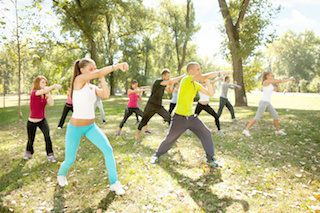 I think we all know people who have for the most part enjoyed exercising throughout their entire lives. They played sports from a young age. They were always on the move as kids – running farther, biking faster, climbing higher, competing harder. On the flip side, there are those who have had to push themselves more motivation-wise in the fitness department. The same degree of activity didn’t appeal from an early age, even all things being equal in living circumstances. How many of us, for instance, know siblings who span the entire spectrum of fitness orientation? What happens not just in childhood but in adulthood when the draw of physical activity isn’t just play but health and longevity. What personalities tend to work out more? Who enjoys it more? And what are the means we can explore to make exercise a more appealing personal endeavor if we’re not among the more naturally gung-ho?
I think we all know people who have for the most part enjoyed exercising throughout their entire lives. They played sports from a young age. They were always on the move as kids – running farther, biking faster, climbing higher, competing harder. On the flip side, there are those who have had to push themselves more motivation-wise in the fitness department. The same degree of activity didn’t appeal from an early age, even all things being equal in living circumstances. How many of us, for instance, know siblings who span the entire spectrum of fitness orientation? What happens not just in childhood but in adulthood when the draw of physical activity isn’t just play but health and longevity. What personalities tend to work out more? Who enjoys it more? And what are the means we can explore to make exercise a more appealing personal endeavor if we’re not among the more naturally gung-ho?
The research on fitness and personality reveals some interesting dimensions. Much of the research revolves around the so-called “big 5” personality traits (conscientiousness, extroversion, agreeableness, neuroticism and openness to experience) as a means of analyzing what exercise choices and behaviors work best for individual people. For example, the more conscientious you are, the more likely you are to exercise regularly. Wherever you fall on that particular scale, logistical choices that support your consistent practice are obviously important. You know how much structure you need.
If you’re extroverted, obviously relying on your own willpower to go it alone for that daily run at 5:30 every morning probably isn’t going to cut it. If you score high on the “open to new experience” trait, novelty should clearly be a priority. If you tend toward the neurotic (not that there’s anything wrong with that), you might consider that regular exercise can balance out your emotional landscape (e.g. anxiety) in positive ways. Convincing yourself to make working out a daily habit might revolve more around recognizing the mental health benefits than the physical. Agreeableness/aggression, for what it’s worth, didn’t appear to influence exercise behavior.
Interestingly, in one study the “neuroticism” trait and its assigned opposite – resilience – showed the most influence on fitness – not just in terms of engagement but performance. The more “resilient” (emotionally flexible) of the 642 participants had a greater aerobic capacity. While the findings don’t reveal a cause and effect relationship, it introduces the question of whether our emotional resilience encourages us to develop our physical capacity or (alternatively) if physical fitness breeds psychological balance. (From a hormonal perspective, I think there’s more evidence for the second.)
While the research might suggest that certain traits make exercise overall a more appealing choice for some people, I think it’s important to not run too far with the idea that certain personalities tend to embrace fitness more or might (in some studies) perform better along given physical measures. Research shows the social environment, for example, significantly influences both adolescents’ and adults’ experience during exercise. When an activity supports a person’s sense of competence, autonomy and relatedness, these studies show, he or she is likely to enjoy it more and feel more motivated. Too often, however, our past experiences around formal “exercise” cut this fulfillment off at the pass. I wonder, in particular, how much of the introvert/extrovert exercise performance or enjoyment discrepancy could be ameliorated by these conditions.
Likewise, any of us can enhance our emotional resilience, whatever our innate “profile” might predispose us to. While we may not be able to shift our introversion/extroversion set points much, I’d venture to say most introverts (certainly those I know and love) say context matters a great deal.
The fact is, there’s much more at work for most of us than a clinically defined psychological trait.
By the time we’re adults, we’ve amassed a significant layering of experiences that definitely color our perception of “exercise” and whether we consider it our bag. Everyone from our parents to middle school gym teachers, extracurricular coaches and (of course) our peers at one point or another transferred their messages about our competence and skill – whether we were “cut out” for fitness or not. Additionally, we decided on some level whether we belonged in the social circles that revolved around athletics or other physical activity. We looked at what was available and considered “exercise” to decide how much interest we had. Maybe we found the options lacking and learned to identify ourselves with other endeavors.
For some of us who weren’t athletes in the formal sense, we were lucky enough to have found a solitary or otherwise alternative means to be active outside of the school-focused extracurricular realm. Maybe we practiced a martial art or dance. Perhaps we were nature buffs and still spent as much time outdoors during our teenage/twenties years as we did as children. Maybe we were bike commuters to jobs or school.
Sometimes it was a matter of practicing an activity that served a given need and more or less stuck with it. It might have boiled down to economics or logistics (e.g. bike commuting, physical labor occupation). Over time, however, I think we come to identify ourselves with our activities (and activity levels) regardless of our original intention behind them. Our fitness levels become less about whether we perceive ourselves to be a “type” and more about how an activity serves a purpose in our practical lives. In a sedentary, car-oriented culture, this is harder to come by these days.
For others of us, however, we found an activity that fit a personal interest. Perhaps we found our way there through social means (e.g. joining friends who enjoyed anything from Ultimate). In other cases, we discovered individual gratification from a solitary pursuit. Maybe an evening bike ride or weekend hike regularly provided a kind of needed therapy through a difficult time. Perhaps we learned that we could experience simple joy through ice skating or swimming laps or caving.
Whatever the case, we forged an investment of one kind of another in an activity and came to see it as part of how we live our everyday life and self-care. This, I believe, is a more potent and sustainable motivator than guilt. Health is one of the few things in life for which the end almost always justifies the means, but why accept obligation when you might enjoy a greater satisfaction?
Thanks for reading, everyone. What do you think of the personality-fitness connection? Has it influenced your choices? How did your find your motivation, and how did past messages support or discourage your identification with fitness? Have a great end to the week.
Prefer listening to reading? Get an audio recording of this blog post, and subscribe to the Primal Blueprint Podcast on iTunes for instant access to all past, present and future episodes here.
You CAN Lose Weight and Get Healthy. Find Out How>>



November 5, 2014
The 10 Rules of Successful Exercise
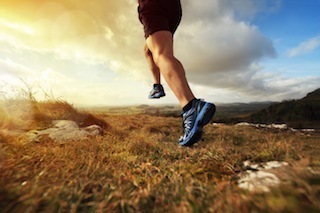 Regular physical activity is important, and everyone pretty much agrees, but life gets in the way. Most of us end up trying to fit exercise in around a busy schedule rich in sedentary behaviors. We’re sitting all the time. We’re spending countless hours at jobs we may not necessarily love. Responsibilities pile up and time slips away before we notice it was even there. We need to make our exercise count. We need to get it right. So today, I’m going to lay out the ten most important rules for successful exercise. These are the rules I use to form my exercise philosophy. These ten items have helped me get fitter, healthier, and happier than I ever was as a professional athlete, and I think they’ll help you out, too.
Regular physical activity is important, and everyone pretty much agrees, but life gets in the way. Most of us end up trying to fit exercise in around a busy schedule rich in sedentary behaviors. We’re sitting all the time. We’re spending countless hours at jobs we may not necessarily love. Responsibilities pile up and time slips away before we notice it was even there. We need to make our exercise count. We need to get it right. So today, I’m going to lay out the ten most important rules for successful exercise. These are the rules I use to form my exercise philosophy. These ten items have helped me get fitter, healthier, and happier than I ever was as a professional athlete, and I think they’ll help you out, too.
You might not need to follow all ten rules. And not all rules apply to all training regimens. That’s fine. But in my experience, both personally and as a coach, the people who get the most out of their workouts adhere to most of these rules.
Do the thing you love.
Some fitness people like to talk tough. They’ll say things like “pain is weakness leaving the body” or “if you’re enjoying yourself, you’re not training.” I get where they’re coming from because hitting the truly elite levels of performance does require enduring pain and sacrifice and unpleasantness and, frankly, momentary bouts of abject misery. But even the triathletes subjecting themselves to crippling pain do so out of love. There’s some hate there, too, but love is the foundation.
The biggest benefit to doing something you love for exercise is that you’ll actually do it. Since the most effective and beneficial exercise is the one you can stick with, this is one way to ensure you obtain the benefits.
There’s not a ton of research on the matter, but what little exists suggests that “forced exercise” isn’t even as helpful as “voluntary exercise.” In mice with colitis, for example, forced treadmill running exacerbates intestinal inflammation enough to kill the mice, while voluntary running attenuates it and keeps them alive. And in a rodent model of Alzheimer’s disease, voluntary exercise was superior to forced exercise at reducing plaque deposition and memory impairment. That’s pretty huge, I’d say.
Do what you love. You’ll actually do it and it’ll probably give you better results.
Get a workout buddy (or buddies).
Besides the workouts themselves, one big reason CrossFit has become so popular and so effective for so many people is the group dynamic it offers. You’re not just toughing it out on your own anymore. And it goes beyond having a spotter. With CrossFit, you have a tribe of likeminded individuals pushing each other, shouting encouragement, suffering and succeeding together. Research confirms the benefits of this kind of camaraderie in the gym:
Working out in a group boosts the stress reduction we get from exercise.
Just working out in the presence of another person reduces the perceived effort of the exercise.
Train with someone who’s stronger/faster/fitter. If you think your workout partner is doing better than you, you’ll work harder.
Guys might also want to work out with a lady nearby, as exercising with a member of the opposite sex has been shown to also reduce perceived exertion. I’m not sure if the same applies to women working out near men; I’d expect it might.
You don’t have to join a CrossFit box (though it’s not a bad idea!). Simply gathering a friend or two for regular workouts will do the trick. And hey, social contact is a nice bonus!
Work out outside.
Taking in a sunset snuggled up with your sweetheart is amazing. Going camping for a half week really recharges your body and soul (and resets your circadian rhythms). Simply being in green space has health benefits. But we’re not only meant to passively and calmly experience the great outdoors on a regular (as close to constant) basis. We should be physically engaging with them, propelling our bodies through three dimensional space at high speeds while immersed in fresh air, and unfiltered sunlight.
Exercising outdoors makes exercise more enjoyable. The more enjoyable it is, the more likely we are to do it. There are also psychological benefits, according to a 2011 meta-analysis. Outdoor workouts resulted in greater revitalization, increased energy, and more positive engagement with the activities, along with less depression, anger, confusion, and tension. I mean, the love of exercise in an outdoor setting even smashes the divisions between species and phyla. If a slug will do it, you have no excuses.
Oh, and if you need the boost, the sunlight will increase testosterone levels via vitamin D production. That’s always nice and helpful for workout recovery.
Incorporate play to make the workouts fun.
One surefire way to make exercise more enjoyable – and thus more sustainable – is to play. Instead of pounding out an hour on the stationary bike, go mountain biking. Instead of doing box jumps, play leap frog with a friend (or do leap frog burpees). Instead of lifting weights, lift oddly shaped objects or oddly shaped people. Instead of running aimlessly, go play sports where you run to get places and catch balls and make baskets (might I recommend Ultimate?).
Or you could overhaul your entire workout program and base the whole thing on play from the ground up. If this sounds interesting, you’ll want to attend a Primal Playout hosted by Darryl Edwards. The guy lives for play and has built up an impressive physique and a lot of strength and power and athleticism simply by having fun. Follow his Twitter and if he’s coming to a town near you, go see him (he’s also a regular presenter at PrimalCon, so check that out too).
By framing your workouts as a “fun activity,” they become their own reward and you’re less likely to reward yourself with junk food afterwards. Oh, and fun is really fun.
Make your workouts meaningful and purpose-driven.
A big problem that prevents people from working out is that it all feels so meaningless. And let’s face it: going to the gym to lift some weights just so you can put them back down or walking on a treadmill for an hour without going anywhere feels pointless on some base level. It wasn’t always this way, though. Humans used to perform physically demanding tasks on a regular basis in order to live, eat, and thrive. It wasn’t “exercise” or a “workout,” but it made us fit, strong, and fast just the same.
Most of us can’t create a life where regular exercise is a prerequisite for survival (nor would we want to), but we can inject meaning and purpose into our movements. Simple things like working with your hands and building useful things, helping friends move, cleaning up a park or nature area, commuting to work on bike or on foot, or doing physical labor can give you a great workout and produce tangible and useful results. Those probably aren’t enough to get you as fit as you’d be lifting barbells or running sprints, but you can do both and still retain the sense of meaning.
Find flow.
Have you ever had a workout that feels effortless until it’s over at which point you collapse under the weight of suddenly realized exertion? That’s flow. When he scored 13 points in 33 seconds, Tracy McGrady was deep in the flow state (or “the zone”). Software developers seek flow to improve their coding. Meditation is stationary flow. That guy wearing shades in the gym, flexing for the mirror in between sets on the pec deck? He’s probably not experiencing flow.
How do you do it?
According to the father of flow research, Dr. Mihaly Csikszentmihalyi, we must engage in doable but difficult challenges that tap into our individual curiosities and interests while giving immediate feedback. Luckily, an engaging workout tends to promote the flow state fairly easily as long as you’re looking for it. Try eliminating distractions that pull your attention from the task. Instead of running on a flat track, for example, go running on a trail that forces you to dodge rocks, jump roots, and pay close attention to where your feet go; the time will fly by and you’ll probably go longer than you would have on the track. Jogging with a podcast in your headphones can be nice, but it’s important to lose yourself in the task at hand sometimes.
You can always flex in the mirror after your workout.
Savor how exercise makes you feel.
Exercise is psychedelic. It expands and alters consciousness. It’s an escape from the drudgery of real life, of bills and deadlines and stress and neurotic thought-loops.
It’s a narcotic, literally causing your brain to produce endogenous opioids and cannabinoids that get you high.
Good workouts reveal the extremes of subjective human experience. We get butterflies before a big lift or a particularly grueling sprint and feel the real anxiety of knowing you’re about to push your body to its limit. We know the joy of victory (even if it’s against your last workout’s self) and the crushing dejection of defeat. The ups, the downs, the all-arounds.
A good workout relaxes you. All is right with the world after a heavy lifting session or a hike in the back country. Food tastes better. The sunset’s prettier. Work stress is somehow less pressing.
You’re confident after a workout. “Yeah, I just lifted that.” You feel sexier, too, because you’ve proven to yourself and the world that you know how to use and inhabit your body.
Even the unpleasant aspects of exercise – the sweat sting, the burn of the quad, the intense mental effort required to lift this weight or run that hill – should be savored. Drawing away from the pain is pointless; it’s there. By meeting it head-on, by enjoying it, we co-opt it for our own devices.
Know these feelings. Savor them. They may not be “fun” or “pleasant,” necessarily. That’s not the point. They’re proof that you’re still alive and that these workouts are doing something.
Release your attachment to the outcome.
As a high-level endurance athlete, I was obsessed with the outcome. During events, I’d strap the outcome onto my chest like a baby carrier and he would help me reach the finish line. And when I’d languish in bed trying to avoid the day’s training, it was the outcome tugging at the sheets and bringing me a cup of coffee. If I didn’t have the outcome – the finish line – I couldn’t have faced all the grueling torture required of elite endurance athletes.
But that’s no way to live. Detaching myself from the outcome and focusing on the journey to wherever it is I’m going has proven to be a game changer for my health, my happiness, and ultimately my fitness. When you can immerse yourself in the journey, in the exercise itself as you’re doing it, great stuff happens. You hit the flow state more easily. You find yourself having fun again when you work out. You discover that training can be an end in itself, and your workouts are reinvigorated and more fruitful.
Keep your goals, of course. Just don’t forget to savor the journey and don’t let yourself fall to pieces in despair if the outcome differs from your expectations.
Decide if you’re training or just exercising.
Which is it: training or exercising? Are you interested in being active, moving your body, getting generally fitter and stronger, staying fit, staying strong without adhering to any specific performance goals? Then you’re exercising. You have goals. They’re just more diffuse, like “get healthier.”
Or maybe you have a specific performance goal, like “deadlift 500 pounds” or “compete in Master’s marathon and actually compete.” Then you’re probably going to be training, which means a training program consisting of progression, regimentation, and maybe periodization. Training is stricter.
They’re both great, depending on your goals, but exercising when you should be training or training when all you really need is to exercise can make you miserable and render your workouts ineffective and meandering. So make a decision so you can achieve your goals.
Me? My goal nowadays is to play until I’m old, so I train to maintain my fitness, my muscle mass, the strength of my connective tissue, and my bone mineral density enough that I’m able to go out and have fun every single day.
Try something new.
Humans are novelty seekers. It’s kind of what drove us to walk the entire globe, explore new surroundings, test our limits, and become the apex predators on this planet. That hardwiring affects our relationship with everything- the media we consume, the games we play, the hobbies we spend time on, the relationships we forge, and the exercises we do.
One way trying a new workout or exercise can help is by boosting enthusiasm. If you’re bored with your workout, you’re bored. You’re going through the motions. You’re doing the minimum and getting minimal results. If you’re excited about what you’re doing in the gym, on the track, or on the trail, you’ll be more into it and you’ll get more out of it. Novelty seekers often feel bad about their desire for something new; they shouldn’t. They should indulge it, especially when it comes to movement.
And when it comes to strength training, it might even be more effective to change up the exercises you do than simply increase the intensity (weight, volume, etc). In a recent study, researchers tested the effects of exercise variation in both beginning strength trainees and early advanced trainees. Compared to varying the intensity, varying the exercises yielded significant strength and hypertrophy gains in both groups. In the words of the lead researcher, changing up the exercises you do in the gym “seems to produce a more complete muscle activation hypertrophying all of the heads of multi-pennate muscles.”
As I said earlier, you don’t have to do everything on this list.
But it wouldn’t hurt.
That’s it for today, folks. What other tips do you have for people looking to improve their exercise game?
You CAN Lose Weight and Get Healthy. Find Out How>>



November 4, 2014
Why I Don’t Trust the Acceptable Daily Intake Levels for Pesticides
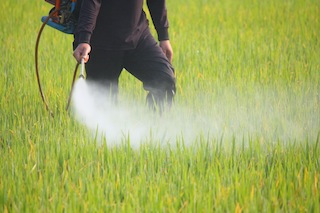 The supernaturally rational adherents to the Skeptic religion irk me. And it’s not because I disagree with all their stances. On many issues, they’re right. But the systematic, overarching, a priori denial of the viability of anything that even sniffs of “alternative” health is ridiculous. I’m not even annoyed at how they deride the ancestral health movement. What really gets me is their flippant dismissal of the potential risks of agricultural pesticides.
The supernaturally rational adherents to the Skeptic religion irk me. And it’s not because I disagree with all their stances. On many issues, they’re right. But the systematic, overarching, a priori denial of the viability of anything that even sniffs of “alternative” health is ridiculous. I’m not even annoyed at how they deride the ancestral health movement. What really gets me is their flippant dismissal of the potential risks of agricultural pesticides.
One article in particular, from Slate in 2012, exemplifies the sloppy, dangerous thinking on the subject. On the surface, it’s quite reasonable, persuasive, and it hits all the marks.
The author is a former organic fanatic for whom “organic was a synonym for edible” – so she’s been to the other side and knows how they think. She was swayed by the evidence. She’s no paid agro-shill.
She “[dug] into the literature” and “[talked] to toxicologists, horticulturists, risk experts, and nutritionists,” those gatekeepers of human knowledge. The all-powerful experts, infallible and untainted by conflicts of interest.
She dismisses the nutritional differences between organic and conventional produce, graciously allowing that the former “may” have fewer nitrates and more vitamin C and completely ignoring the evidence that shows major differences in other important nutrients.
She claims that “organic produce has pesticides too!” and focuses on rotenone, an organic pesticide that’s more toxic by weight than many synthetics and which organic food is presumably swimming in. Good thing organic farms in the United States aren’t actually allowed to use rotenone on their crops.
She’s unable to find solid numbers on pesticide residues on organic produce, concluding that “yes, organic produce can be pesticide-tainted, too.” Luckily, solid numbers do exist and organic produce is far less likely to be “tainted.”
But there’s another, maybe larger problem underlying this article and others like it: the unflappable acceptance of the Environmental Protection Agency’s safety assessments for synthetic pesticide intakes. You see, before pesticide manufacturers can sell their products in the United States, the EPA “must evaluate the pesticides thoroughly” to ensure they’re safe for humans and the environment. They then use this data to determine the ADI – the acceptable daily intake – for each pesticide. If a pesticide is being legally used in the United States, you have the authorities’ assurance that it’s totally safe.
I wish I could agree with them. I’d end the post here, leaving you snuggled up with the EPA’s cozy assurances that everything is going to be okay, you don’t need to waste money in the organic aisle, and you can stop bothering those nice vendors at the farmer’s market with silly questions about pesticide usage. But I’m afraid I can’t do that in good conscience.
Those EPA safety assessments have a few shortcomings. A recent paper highlights the weaknesses in the current regulatory environment surrounding pesticides in this country:
Pesticide manufacturers conduct the studies that produce most of the data the EPA uses to assess the pesticides.
In theory, the EPA accepts safety data culled from independently-funded pesticide studies, but the independent studies rarely satisfy the stringent and expensive eligibility requirements. The EPA works with the pesticide industry to establish these requirements, including study designs and methodologies that are often prohibitively expensive for non-industry researchers to fulfill (PDF). This usually leaves industry-funded research as the only viable options for inclusion and consideration. And industry-funded studies almost always get results that are favorable to industry. For instance, the easiest way to predict whether atrazine (an herbicide commonly used on corn and sugarcane) has biological effects in a study is to look at the funding source.
This constitutes a clear conflict of interest. It’s not incontrovertible proof of collusion or malfeasance, but it makes me uneasy.
Commercial pesticide formulations aren’t representative of the isolated active principles being tested in safety studies.
Pesticides aren’t just single chemicals. Commercially, they’re actually collections of various chemicals called formulations. These formulations contain the declared active principle, which is what the safety studies test, and adjuvants, which are supposedly inert and therefore safe. You know how toothpaste has active and inactive ingredients? Same thing here. Just like the supposedly inactive ingredients in toothpaste can have some physiologically significant effects, the adjuvants in pesticide formulations can alter the effect of the active principles.
Adjuvants aren’t included in pesticide formulations for the heck of it, you know. They perform important roles. Some are surfactants that, when included in a pesticide formulation, allow the pesticide to penetrate the cellular walls of insects, fungus, plants, and other pests. Others act as thickeners, emulsifiers, and anti-condensates that improve the distribution and resiliency of the pesticide. They can help pesticides resist rain, runoff, and evaporation. Adjuvants increase dermal absorption of pesticides, too. They are penetrants, remember? In other words, they make pesticides more effective, more resilient, and more damaging to pests; otherwise, they wouldn’t be included. And according to a recent paper, many adjuvants also amplify the toxic effects of pesticides on human health.
Using isolated human cells, the researchers compared the effects of nine popular pesticide formulations with those of their isolated principle ingredients on mitochondrial activity and membrane degradation. In 8 out of 9 instances, the commercial formulations were on average hundreds of times more toxic than the principle alone. The fungicides were the most toxic, followed by the herbicides, then the insecticides (which were comparatively less toxic). Of the herbicides, the extremely popular Roundup was 125 times more toxic than glyphosate, its principle ingredient.
The worst part of all this: most of the safety tests study the active principle, not the full pesticide formulation. This isn’t a new problem, either. As far back as 2006, researchers were questioning the logic behind allowing largely untested adjuvants into the food system via regulatory backdoors. This should be a no-brainer. If you’re assessing the toxicity of Roundup (Monsanto’s popular herbicide that goes on absolutely everything these days, from soybeans to your city parks), you have to actually test the toxicity threshold of Roundup – not just glyphosate. Right?
Pesticide safety studies rarely account for synergy between multiple pesticides.
Real world pesticide exposure doesn’t resemble laboratory pesticide exposure. We’re not exposed to one pesticide and given sufficient time to excrete it. We’re exposed to dozens of them, often all at once, in uncontrolled environments. Could the EPA be underestimating the cumulative effects of multiple pesticides? There’s evidence, at least in animal studies using coho salmon, honeybees, and rats that certain pesticides may be synergistic; when combined, their effects become greater than the sum of their parts. I don’t see why humans would be exempt from the effects of pesticide synergy.
If the effects of exposure to multiple pesticides were merely additive, that’d be one thing. We could tally up our exposures for each, compare them to the ADI, do a bit of simple arithmetic, spend several days trawling the pesticide literature for human health effects, and know where we stand. But if the effects of multiple pesticides are synergistic, if the effects are greater than the sum of the parts, we can’t rely on addition or the EPA’s assessments. Sure, you’d have to evaluate pesticide synergy on a case-by-case basis, and it’s going to be incredibly resource-intensive, but it must be done if we want accurate ADIs for pesticides.
Okay. What now?
Frozen with fear? Frantically purging your kitchen of all conventional foods? Don’t. That wasn’t my intent. Babies (including the yet-to-be-born) and children should probably go as organic as they can, just because of the unknown and potentially large effects pesticide exposure has on developing systems. Pregnant women, too. And if you eat a lot of these 9 foods, go organic as often as possible because they contain high levels of pesticide residue. But we all need to eat food, and eating conventional produce is healthier than eating none at all. Besides, there are plenty of non-organic foods that you can safely eat.
I just wanted to temper the unflappable faith many people seem to have in the experts, the institutions, the agencies. I wanted to get people talking and thinking. The EPA doesn’t deal in absolute truth; they miss an awful lot, either out of ignorance or because they’re looking the other way. No one does. I certainly don’t. If you meet someone claiming to have all the answer(s)? Run.
Let’s hear from you guys, now. What are your thoughts on pesticides and ADIs? The illusion of authority? Reassurances from the experts that their numbers are correct and you have nothing to worry about?
Thanks for reading.
Prefer listening to reading? Get an audio recording of this blog post, and subscribe to the Primal Blueprint Podcast on iTunes for instant access to all past, present and future episodes here.




November 3, 2014
Dear Mark: Oxidized Coffee Oils, CrossFit or PBF After Injury, Enduro Mountain Biking, and Pressure Cookers
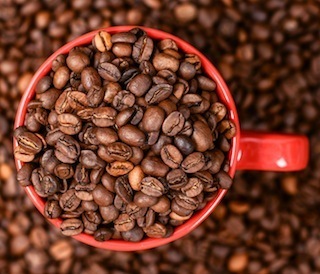 For today’s edition of Dear Mark, we’ve got a four-parter. First, is it a problem if the oils in coffee beans are oxidized? Should we avoid them altogether? Is coffee coffee? Next, what should a guy who just recovered from an injury do for exercise: CrossFit or Primal Blueprint Fitness? After that, an enduro mountain biker wonders whether her interval-less training program could benefit from a few interval workouts. If you don’t know what enduro mountain biking is, you’ll find out below, so don’t worry. And finally, I explore the benefits and any downsides to using a pressure cooker to cook your soups, stews, and broths. Are we destroying nutrients?
For today’s edition of Dear Mark, we’ve got a four-parter. First, is it a problem if the oils in coffee beans are oxidized? Should we avoid them altogether? Is coffee coffee? Next, what should a guy who just recovered from an injury do for exercise: CrossFit or Primal Blueprint Fitness? After that, an enduro mountain biker wonders whether her interval-less training program could benefit from a few interval workouts. If you don’t know what enduro mountain biking is, you’ll find out below, so don’t worry. And finally, I explore the benefits and any downsides to using a pressure cooker to cook your soups, stews, and broths. Are we destroying nutrients?
Let’s go:
Hi Mark,
I have been roasting coffee at home for about a year now and I will never go back to buying old, stale coffee from the store. That got me thinking though…what oils exist in coffee? Are the oxidized oils covering the store-bought coffee much worse than the oils in fresh-roasted coffee or does the roasting process oxidize the oils anyways?
Thank you for all you do,
Kevin
Have you ever opened a bag of coffee to reveal a sweltering throng of greasy, sweaty black beans that clog your grinder and leave a film in your mug? Those are coffee oils rising to the surface after (excessive) roasting. They’re now exposed to the air and, being roughly half linoleic acid, almost certainly oxidized.
The lighter the roast and the fresher the coffee, the lower the oil oxidation. Keeping it in whole bean form also increases the resistance, while grinding it prematurely will oxidize the oil and mar the taste.
All that said, I find fretting over the health effects of oxidized oils in coffee unnecessary. Consider that the vast majority of evidence, both epidemiological and controlled, points to coffee in general being incredibly beneficial. It seems to reduce the risk of diabetes, all cause mortality, Alzheimer’s disease, Parkinson’s disease, and liver cirrhosis. These studies mostly consist of normal coffee drinkers enjoying normal coffee, not the small minority of folks consuming only single-origin light roasts. And dark roasts even seem to be better than light roasts at increasing antioxidant status and reducing bodyweight in healthy coffee drinkers.
The best reason to avoid oxidized coffee beans is because you don’t like the taste. Don’t stress the health effects too much.
For the Dear Mark session I have the following question:
I am a 36 year old who used to have 100lbs of overweight 14 months ago. I started 14 months ago. Eating primal. And following a fitness program made for me by a personal trainer, which was basically bodyweight excercises. Lost approx 50lbs in 6 months.
My personal trainer then advised me to advance to doing CrossFit. Although I hesitated, I had a go at it. The eight months that followed were both positive and negative. I lost another 16-20lbs, but it didn’t go as smooth as the first 6 months. I got more cravings for carbs, got several injuries that prevented me from several exercises and even had me out of the gym for two months.
My question to you is: what is your suggestion now that my injury is healed. Get back into the CF gym? Or go back to, for example, PBF LHT with my bodyweight and first try to get stronger and lose the 40lbs of fat I still have to get rid of?
Question 2 if your answer to question one is PBF:
I don’t have a pull up bar in my house and I hate the iffy things people install on their doorposts etc (too many fail videos on youtube lol). Is there any other way to do pull up progression? Maybe TRX?
Regards
Bart
Hi, Bart.
Question 1: Without knowing the CrossFit box in question, it’s tough to say.
I lean toward the program that already worked without causing injuries. You can always move on to something else, but you know it’s a safe option and it’s already worked. It’d be a nice way to ease back into regular training.
If you go back to CrossFit, see if you can focus on strength training. Many CF boxes have different tracks. They’ll have an Olympic lifting track. A strength training track. A more traditional metabolic conditioning (WODs) track. In your situation, I think a focus on strength is safest. This will build strength (obviously), strengthen your joints and connective tissues (so they can take the pounding you receive during high intensity WODs), and get you familiar with many of the movements commonly performed at high speed for time. Otherwise, I worry your body will just break down again.
Later, after building up your strength and mastering the lifts, you’ll be ready to handle more high intensity metabolic conditioning – if that’s what you want to do.
Question 2: Yes, a TRX setup will work, as long as you have a suitable overhead horizontal anchor point to work with. You can use vertical anchor points, but you won’t be able to do pullups. Another option is a set of gymnastics rings. I can vouch for these rings, and I’d actually recommend rings over TRX because the room for growth is much higher with the rings. TRX is designed for beginners (which is awesome, don’t get me wrong). Rings are designed for beginners and Olympic athletes.
The advantage of TRX or ring pullups is the freedom of hand positioning. You can do all sorts of different pullup positions on rings or straps, whereas with an overhead bar you’re limited.
Also, any stable (or even slightly unstable) horizontal overhead surface can work as a pullup bar. Got any overhead beams or ledges? A ledge restricts your grip and forces you into fingertip pullups, which are excellent builders of grip strength. Or how about trees? A tree branch is great, and I’ve always found I can somehow do more pullups on a tree branch than on a pullup bar. Not sure why. If you have access to the underside of a stairwell, you can do pullups there, too. The world is full of pullup bars once you start looking.
Dear Mark,
I am a competitive ‘enduro’ mountain biker living in Ireland. I compete in the Enduro World Series and other international races. I have just been given an 8-week training programme from a personal trainer (who is a ex professional downhill racer) and after reading your latest post on interval training vs endurance I’m confused as to what to do.
My programme is 2rs on road bike/turbo trainer, 3 x per week; 2 x strength training per wk, Saturday skills on mtn bike, and a 6km mountain run on a Sunday. The aim is to condition my muscles and lose body fat. However, after reading your article, it sounds like I should be doing interval training which will reap the same benefits as long hours on the bike. Is this true in my case? Where I’m in pre-season training (race season begins in April) is it better for me to go with interval instead?
I appreciate the number of emails you must get so at your convenience.
Kind Regards,
Michelle
Great question, Michelle. Although I’ve never done much mountain biking, I have quite a few friends who are heavily into it and the rise of enduro racing has really intrigued me. For those who don’t know, enduro racing involves timed downhill portions with untimed uphill climbs to get to the start of the next downhill leg. It seems to require a mix of skill (sprinting down a mountain trail with jumps and quick turns and rocks and roots takes great precision and on-the-fly decision making), endurance (though the climbs aren’t timed, you still have to do them fast to get to the next downhill race), and strength (mountain biking takes a lot of lower body strength and a surprising amount of upper body strength).
Check out this video from a race in Colorado. Looks like a heck of a lot of fun.
Many enduro downhill legs last about ten minutes, with full-out sprints on the straightaways. And “downhill” doesn’t mean a straight shot down. They also include lots of climbs, even though the overall trend is downhill, so you need to be able to push hard up the inclines. Intervals definitely have a place in your training because your events resemble intervals.
Intervals do work. When you’ve got marathoners and triathletes and other exclusively endurance athletes using interval training to improve their performance, there’s no question athletes whose events actually resemble intervals can benefit from training them, too.
That’s not to say you should give up the longer rides. They’re valuable, too. And hey, you can always embed interval training into those longer rides.
Intervals can be longer than the 20 seconds on, 10 seconds off Tabata-style intervals that are popular in science reporting and probably aren’t even the most effective way to improve performance. You can do several sets of 4 minutes on, 4 minutes active rest. You can do 15 seconds on, 15 seconds off. They both increase endurance more than moderate training. Other research indicates that shorter intervals work best with longer (relative) rest periods, and longer intervals with shorter (relative) rest periods. So instead of 30 s on/30 s off, you’d rest for 4 minutes. Or if you were using 4 minute work periods, you’d only rest for 1:30. A mix of each would probably be best. Short and intense intervals with longer rest periods, plus longer, easier intervals with shorter rests.
Of course, I can’t tell you how to structure your program. I don’t have any specific experience in training mountain bikers and I’m certainly not a former downhill professional. But I would run the interval stuff by your trainer to see what he or she thinks.
Mark – What side do you take on using pressure cookers in making broths/stocks and soups/stews?
Does this in any way affect the nutritional content in meats and or vegetables?
Thanks,
Wai
I love the pressure cooker.
Cook a whole chicken in 45 minutes. Fall-apart beef shanks in 50 minutes. An hour or less for rich viscous chicken broth that gels at room temperature. What’s not to love?
But it does expose food to higher temperatures than regular sea-level boiling (250 degrees °F/121 °C versus 212 degrees °F/100 °C). And since we have the notion that higher temperatures destroy nutrients, it’s natural to worry about the nutrient content of our pressure-cooked food. But should we?
No. Research indicates that pressure cooking is gentler than most other forms of cooking and actually preserves a lot of nutrition.
In spinach (and amaranth leaves, if you can get them), pressure cooking preserves the vitamin C and beta-carotene content more than open pan cooking (which sounds like sautéing). It also preserves calcium and increases iron absorption.
Broccoli is great in a pressure cooker, retaining 90% of its vitamin C and almost all of its sulforaphane (a very healthy broccoli phytochemical, perhaps the best known and most studied).
Pressure cooking uses less water than other cooking methods, minimizing the leaching of nutrients. If nutrients are lost, it’s not to the ether; it’s to the cooking liquid. And since soups, stews, and broths involve consumption of the cooking liquid, you won’t be missing out on much. Soups, stews, broths, and any other dish where the liquid is consumed with the meal are thus perfect for pressure cookers.
Most pressure cooking research centers on nutrient retention and loss in grains, legumes, and vegetables, but there’s at least one reference discussing how it affects fatty acid and cholesterol oxidation in mutton (and, I presume, most other animal products). Anytime you cook meat, you’re going to oxidize some of the fat and cholesterol. It’s an unavoidable consequence of applying heat to these substances. However, compared to broiling it, pressure cooking mutton results in fewer oxidative changes.
Oh, I almost forgot one more thing. Anti-pressure cooking zealots (sure, they exist) often bandy about the “denatured protein” canard: “Using a pressure cooker will denature the protein in your food and forever alter the structure of the amino acids. Also something about enzymes.” To that, I say: “Great!” I love denatured animal proteins. Denatured proteins are generally more digestible than undenatured proteins. We’re always denaturing the proteins we eat before we eat them. It’s kind of the whole purpose of cooking. When we cook egg whites, the proteins become denatured and more digestible. When you stick seafood in a lime juice bath to make ceviche, you’re denaturing the proteins. That doesn’t “destroy” the proteins or make them toxic or carcinogenic or unrecognizable to our easily-fooled digestive enzymes; it just rearranges them. They’re still broken down in the gut into amino acids.
If you’re convinced, I’m a big fan of the Instant Pot electric pressure cooker. You hear a lot of horror stories about the stove top pressure cookers exploding and coating the kitchen and its inhabitants in molten chili. That’s impossible with the Instant Pot. Very difficult to mess up. And making bone broth is a cinch in one. Just add bones, water, and press a few buttons. It even has a sauté mode, so you can brown your meats before braising them without getting another pan dirty.
That’s it for today, everyone. If you’ve got any additional comments or advice for today’s round of questioners, chime in down below. Thanks for reading!




November 2, 2014
Weekend Link Love – Edition 320
 Research of the Week
Research of the WeekPaleo and Mediterranean diets are associated with equally low risks for colon cancer.
Feeding meat as a complementary food to breast-fed infants increases growth, but not body fat.
A deleterious genetic variant normally associated with hypoketotic hypoglycemia and high infant mortality is extremely common among Arctic populations who traditionally consumed a high-fat, high-protein diet, suggesting that it wasn’t always so deleterious.
Cocoa flavanols improve memory in older adults.
Side planks improve scoliosis and reduce spinal curve.
Three glasses of milk a day linked to increased mortality and more fractures in women. Fermented milk, however, had the opposite effect.
Ancient Polynesian seafarers likely made it to South America, according to new genetic evidence.
New Primal Blueprint Podcasts
Episode 40: Interview with Ben Greenfield, Author of Beyond Training: Host Brad Kearns talks to Ben Greenfield, endurance athlete, trainer, and author about the need for balancing newer training methods with older ones, how to use heart rate variability monitoring, and the intersection between Ben’s training methodologies and Primal principles.
Each week, select Mark’s Daily Apple blog posts are prepared as Primal Blueprint Podcasts. Need to catch up on reading, but don’t have the time? Prefer to listen to articles while on the go? Check out the new blog post podcasts below, and subscribe to the Primal Blueprint Podcast here so you never miss an episode.
Better Than a Marathon: The 1 Mile Challenge
G’Day Australia – The Primal Hotbed
The Definitive Guide to Saturated Fat
How to Accept Your Imperfections
Interesting Blog Posts
How the placebo effect is more interesting and powerful than previously imagined.
Cumin as a powerful weight loss aid.
I give some advice on how to get big in a healthy way over at Spot Me Bro.
A great review of PrimalCon at Experience Life. (Experience Life is giving MDA readers a discount on their print mag. Use this link to get a discounted rate, 2 free issues and 4 free guides.)
Media, Schmedia
I gotta say: I like Steven Rinella’s idea of fitness.
A fair look at the gluten issue from The New Yorker.
Everything Else
Brain researchers are studying surfers to see “what stoke looks like in the brain.”
A bionic boot promises to enable running speeds of 25 MPH (and eventually even faster). I think I’ll wait for bionic knee and hip joints first.
What’s this video of night skiers in LED suits got to do with Primal health and fitness? Not much, honestly (and it might even disrupt your circadian rhythm), but it’s cool.
Farms are using more antibiotics than ever.
What a disgrace of an “artist.”
Pesticides might be making farm workers depressed.
Despite the push to place more patients on statins, most British GPs are resisting.
Ikea’s got a slick new button-adjustable stand-up desk.
Sorry, vegans. Plants know when they’re being eaten.
To maximize dermal BPA absorption from receipts, be sure to use liberal amounts of the hand sanitizer provided at grocery store entrances.
Recipe Corner
With colder weather coming, it’s high time for a Thai red fish curry.
Baby, get yourself a North African stew going.
Time Capsule
One year ago (Nov 2 – Nov 8)
A Beginner’s Guide: Why You Should Practice Meditation and How to Get Started – You’ve read enough about meditation. You just need to do it.
How to Manufacture the Best Night of Sleep in Your Life – Do sleep the right way.
Comment of the Week
You’re right. It’s not Tolkien. It was one of the lines given to Gimli in the film to make him a comic relief character.
In fact, the opposite is true. Dwarves have amazing endurance, and can cover very long distances quickly whilst hauling heavy loads and are still able to fight at their destination (e.g. Dain’s people in the Battle of Five Armies). That’s not to say they aren’t good sprinters—they certainly run for their lives with the best of them—but cross country is something they are pretty darn good at.
But we are not built the same way as dwarves, so taking fitness advice from them might not be a good idea.
– An excellently nerdy comment, the best kind.
You CAN Lose Weight and Get Healthy. Find Out How>>



Mark Sisson's Blog
- Mark Sisson's profile
- 199 followers



